Tutorial: how to increase wire spring in your cradle
I'm here with an actual tutorial for once so get your drafting stationery ready! It is my personal belief that a lot of us struggling bra makers should be increasing the spring on our bras, especially in larger wire sizes. Spring is, in short, the distance between the wire at rest and the cradle the wire fits into.
An extended edition of this post is available on my ko-fi, which you can read with a one-time donation of $3/£2. You can subscribe to continue supporting my work and receive early access to/extended versions of my posts.
Using a spring-conscious approach has been the final puzzle piece in fitting bra bands onto myself and clients with high rates of success. What I mean by spring conscious is the understanding that each wire size/type/firmness needs a different amount of spring, as well as the understanding that certain cradle and band alterations also impact this amount. As designers often use a set amount of spring for each wire, their bands may be relatively successful for smaller wire sizes but fail in larger ones. Today I will show you the basics of how to increase the spring in your cradle. In the extended version, I go over some nuances of springing larger wires as well as ensuring your new cradle fits well into the band.
Symptoms of a lack of spring
Wire Symptoms
- Pain in the gore tip and outer wire tip (including over the course of the day)
- Alternatively, the wire tip floating out and poking into your arms (it depends a bit on the stiffness of the wire and some other factors)
- Pain in the bottom of the wire, like it's digging into your ribs
- Feeling like the bottom outer wire corner is floating, or alternatively feeling like it's sitting on breast tissue
- Wires riding down
- Overall feeling that something isn't quite right with your wires
Band, Cradle, and Cup Symptoms
- Wrinkles in the fabric emanating from the bottom corner of the wire
- Wrinkles in the side seam of the bra
- The side seam collapsing/ the overall band not sitting up as high as it ought to at the upper edge
- Looseness on the upper band
- Looseness at the armpit of the cups
- Straps sitting widely in the back
- Wrinkles in the back band going to the hook and eye
- Band riding up, especially in the area between the straps
- Fabric digging in at the bottom of the gore, prompting you to think about adding a gothic arch
Wow, so many symptoms from just one problem?! Sounds to me like you're going a bit overboard here, HugsforYourJugs.
I know it may come across like I have a hammer and now believe everything is a nail, but as I wrote earlier, this method has allowed me to fit bands on a variety of people with much higher levels of success. From my own personal experience, when I started using this method of increased attention to spring my own bra makes transformed from feeling a bit dodgy and uncomfortable to wear all day to feeling like the well-fitting ready-to-wear bras I reach for every day.
A caveat:
I will say that the symptoms listed above are not solely caused by a lack of wire spring, as the wire is one single part of the entire system of the band. A lack of spring can be considered what I call a "band tensioning issue", and the issues listed above are all symptoms of a band tensioning issue, but lacking spring is just one of the causes of band tensioning issues. It can be hard to tell which cause of band tensioning issues you're having just by inspecting the fit. If you experience these symptoms, you should check to see if spring is the cause by manually springing your wire on the cradle, but it may not be.
How to increase spring:
1. Place your wire on the old cradle, aligning the bottom of the wire with the bottom of the cradle. This point on the wire is known as the balance point.
1.5 Lower the wire by 2mm. This is to account for the wire sitting
inside channelling. The wire naturally sits on the inside edge of
channelling when worn so it just needs to account for the edge of the
channel.
2. Counter-rotate the wire by lowering the gore and raising the armpit edge, moving the balance point outwards. How much you do this depends on the amount of spring you are going to be using. More spring = more counter rotation.
This is because when you spring the wire, the entire outer edge drops down, so this helps keep your sprung cradle shape in the correct position
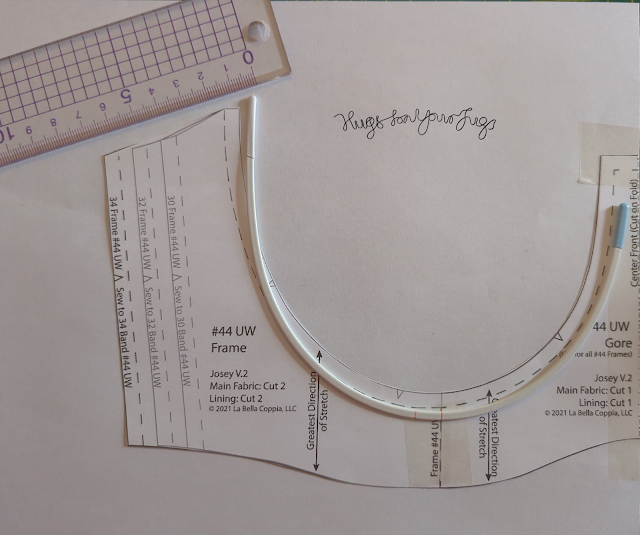 |
| Notice how the balance point has shifted after rotating |
3. Manually open the wire to the point of firm resistance. This again is a bit of an art, it's probably more spring than you expect. The amount a wire springs depends on the snugness of your band. If you prefer a firm band, you should really go for it, but if you don't need much support, you will be ok with less. You're trying to simulate how much the wire will open under the tension of your band.
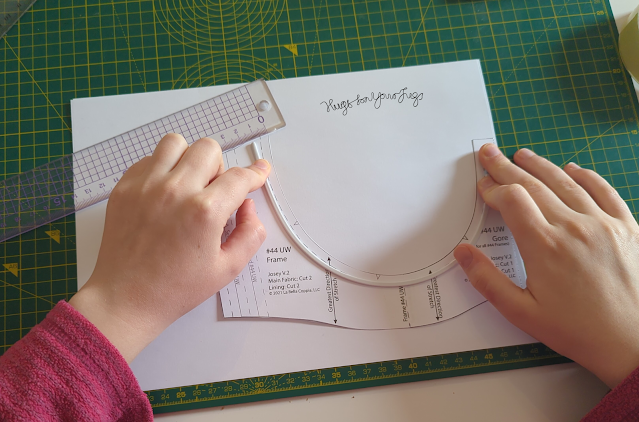 |
| The original spring on this wire is about 1.5cm. We're going to increase that considerably. |
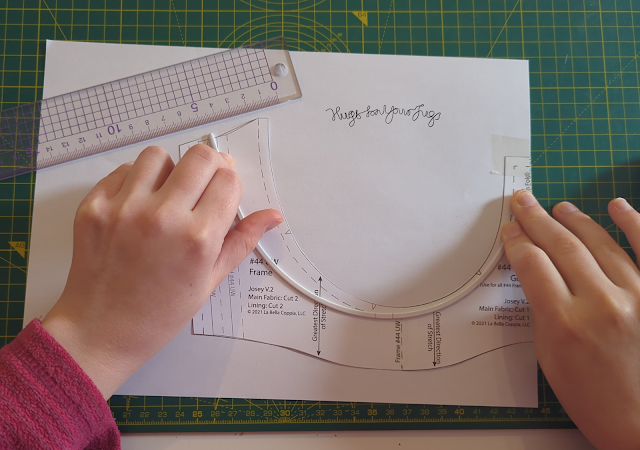 |
| I am springing this heavy duty 44V wire by 4.5cm |
4. Trace this opened wire shape. You might need an extra set of hands if you're using a larger wire.
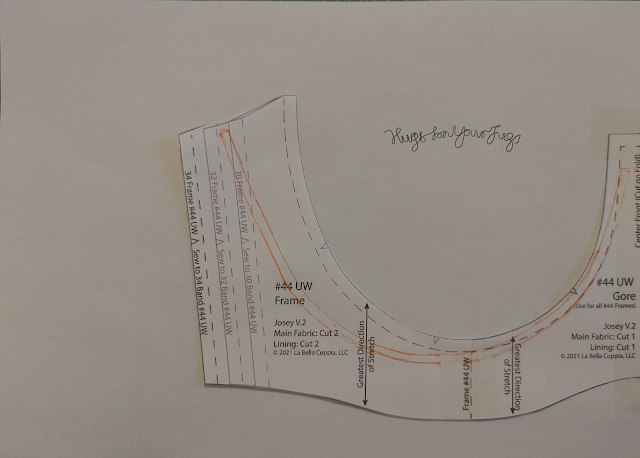 |
5. Add in about 4mm of extra space at the centre front and about 7mm of space at the outer wire tip for wire play (space for the wire to shift in the channel)
6. Trace a line 2mm inside of your wire trace, for the same reasons as in step 1.5
7. Add back your seam and elastic allowances
8. Blend the upper band edge into your original wing pattern.
And you're done!
Now, you may experience issues with the side seam length and position: your new cradle height may be different and the wire trace may sit outside the original side seam. These are minor issues that can be compensated for easily when blending your new cradle into your old band. If you would like detailed instructions you can take a look at the tutorial on the extended version of this blog post.


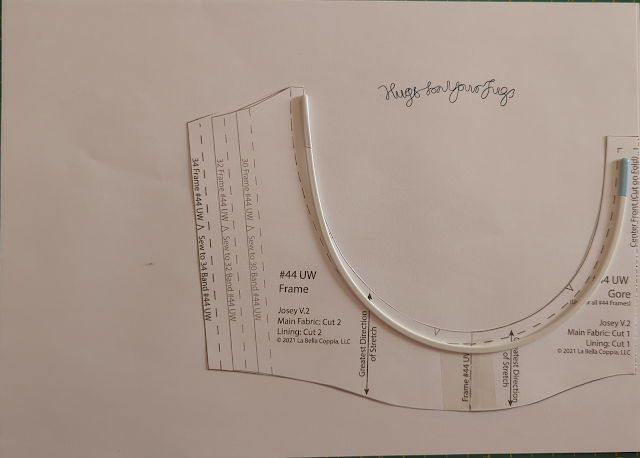
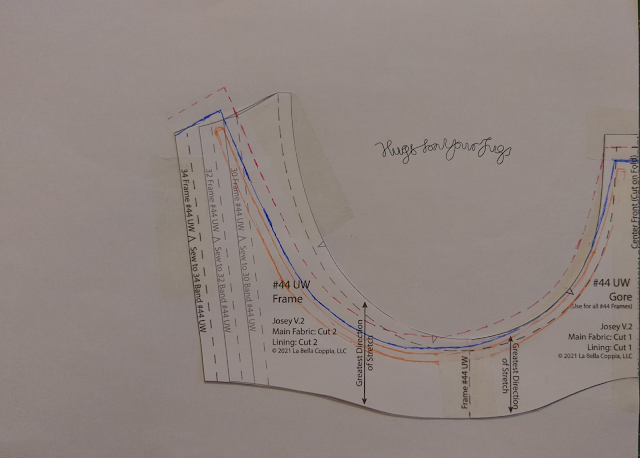
How does this affect the cup fit? I’m pretty sure this is the problem in my current bra draft as I physically move the wire out beyond my outer tissue when putting it on and it floats a bit still, but moving the wire out that far changes the wireline dimension, right? My cup fits my tissue well but since it is a self draft to have more seams, it barely fits the wireline due to seam trying/seam allowance struggles. If this is answered in the extended post let me know and I’ll happily cross the pay boundary.
ReplyDeleteIncreasing spring means that the HH of the cup should increase along with it to maintain a good BCD/HH ratio (I have a blog post on this). However I will say that many cups in current patterns on the market are designed with dimensions that suit a more sprung cradle than they actually have, so I would use your old cups and then if you are getting symptoms of a too short HH in comparison to BCD then add some width to the outer edge of your cups.
DeleteIf you have wire sping, does that mean that Gore will result in automatically being somewhat pivoted?
ReplyDeleteI am making a bra for someone and I had to close the Gore a tad bit, especially at the Bottom. Like you mentiod, prettymuch turnt into a Gothic arch but the cups have also twisted / pivoted a little bit which ended up causing the wire to spring. Does a wire spring usually accommodate for a closer Gore?
It depends a bit on a few things. If, when initially positioning the wire, the gore is lowered, then yes the lower gore will become a little wider. Using double spring will alter the gore further. It doesn't have an impact on the width at the top of the gore.
Delete"Causing the wire to spring" - this was not caused by the cups but by an imbalanced tension distribution in the band. I can't say for sure what happened but many gore alterations end up rotating the entire wing which has a big impact on how it functions. Additionally, many gothic arches are cut too high which destabilises the inner half of the wire.
You said in the "caveat" to test whether spring is the problem by "manually springing your wire on the cradle". How do you do this?
ReplyDeleteI am a 44 long uw and love the Josey 2 pattern as well. I split the gore and added 1/4” (1/2 total) which helped my lower cup flat spot somewhat but I want to try springing the wire like you show as I occasionally get poked under my arms. I also wonder how to handle an empty top cup? I am fuller at the bottom but the flat spot interferes with reducing the bottom cup (or can it work in conjunction?).
ReplyDeleteIf I am understanding this right the pattern pieces should reflect the sprung shape of the wire not the unsprung shape? Wouldn't the power net and elastics just pull the wire to the sprung shape?
ReplyDeleteHi,
DeleteYes - the pattern pieces should reflect the sprung shape of the wire.
Unfortunately the power net does not pull the wire to the sprung shape. What happens when you wear a bra with an unsprung cradle is the band opens the wire a little bit, then because of that wire opening, tension is let off the upper band and so it doesn't spring open any more. This means the wire is only under a small amount of tension and is free to move around and poke.
Thank god for this blogpost. I kept having trouble with the eve classic bra, but was really hesitant to change the sewing pattern, as I had zero experience with that. Lo and behold: I followed your instructions, accounted for wire spring and the mockup bra I came up with hugs me like a friend. Idiot me should have listened from the beginning. Would have saved me a lot of time and nerves. Anyway: Thank you for sharing your knowledge! <3
ReplyDeleteThank you for the update - I'm glad you got there in the end!
Delete